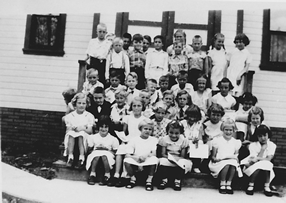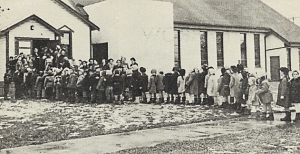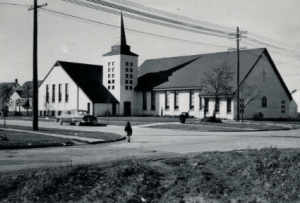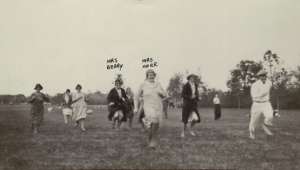Harrow United Church is a group of people worshiping God in word and action.
As a community of faith, we seek to be: inclusive and inviting; Grounded today in the teachings of Jesus as found in scripture and tradition; Sensitive and responsive to God”s Apirit.
“Caring and sharing” characterize our life together in the congregation, as well as our stance toward the larger community and the world in which we live.”
Since 1916 Harrow United Church has been a centre of community activity and a place of Christian worship, nurture and service. From its beginnings as the Sunshine Hall on Arbuthnot, offering a place for children and youth in the growing Crescentwood neighbourhood, to its present incarnation on the corner of Mulvey and Harrow, the congregation has always had an outward focus, looking for ways to make a difference in the community and the wider world. Nowadays, we have the opportunity to do that in a multitude of ways. You can participate in our virtual community or in our “in-the-flesh” community. Or both. Either way, we invite you to experience Christian community, to grow in compassion, and to discover how you can use your gifts to bless the world.
Worship services are Sundays at 10:30 a.m. guests and visitors are always welcome to join us.
Interested in learning a bit about our history?
HARROW’S HISTORY
Early Days
One summer afternoon in 1916, Mr. James Hooper, 195 Nassau Street, was taking a Sunday afternoon stroll across south Fort Rouge and was disturbed by the great number of children who were without Sunday School accommodation. His concern at that time resulted in a meeting at his home on a Thursday evening, November 16, 1916. This meeting was attended by representatives of three churches in the adjoining Fort Rouge area: Crescent Congregational, Fort Rouge Methodist and Augustine Presbyterian.
The following were present:
T. Gordon Russell and J. Cameron – Augustine Presbyterian
Frank A. E. Hamilton – Fort Rouge Methodist
C. G. Stewart, James Hooper, Dr. Wallins and A. D. Hansen – Crescent Congregational
Officers were elected as follows:
Chairman – T. G. Russell
Treasurer – C. G. Stewart
Secretary – F. A. E. Hamilton
We were fortunate that Mr. Hamilton, later to become Judge Hamilton, faithfully recorded our early history.

An abandoned store located at the northeast corner of Scotland Avenue and Aynsley Street (Arbuthnot Street), later to be known as Sunshine Hall, was made available without charge by a Mr. Broadbent. The first service was held on Sunday, December 10, 1916. Mr. James Hooper was appointed first Superintendent of the Mission. Two or three years later the congregation moved to the corner of Stafford Street and Dudley Avenue and became known as the Stafford Street Mission. During the first summer there, services were held in a large tent. By fall, a building had been erected.
The first move – from Arbuthnot to Harrow
In 1930 the congregation, under the leadership of Student Minister David Owen (later Rev. Dr. David Owen of the University of Winnipeg), had a new church built on the northeast corner of Harrow Street and Fleet Street and the name was changed from Stafford Street to Harrow Street. This fine little mission building, with its pot-bellied stove as its only source of heating, proved quite adequate up to the end of the Second World War.


By this time much growth had taken place in the area and, to meet the challenge of this era, the congregation called its first regular Minister, Rev. D. Bruce Johnson of Sidney, Manitoba, who arrived during July, 1947.
All of his predecessors had been either students or ministers in retirement. Even in the summer of 1948, the site of the present church was a field of scrub oak which stretched right out to Cambridge Street. This was soon to change and the church with it.
Building The New Church – another move from Fleet to Mulvey
The Annual meeting of the congregation held on January 19, 1948 appointed the following to serve as a Building Committee: Malcolm Galston, George A. Ivey, Dr. J. Roy Martin, Jack R. Stuart and W. Leonard Wilson. Others subsequently added to the list were: Jack W. Griffiths, John D. McWhirter, Cyril Snell, Jim Anderson, Aubrey Bayne, Tom Beckwith, Lawrence Armstrong and Mel Dempsey. The first Chairman of this Committee was Jack Stewart. This office was later assumed by George Ivey, who for many years was Chairman of the Committee of Stewards. The enduring gratitude of the congregation is due to these men for their untiring efforts to bring to fulfillment the dream of a new church building.
At a meeting of the congregation held on April 27, 1948, it was agreed to purchase the present Mulvey and Harrow property as a site for the new building. On Sunday, November 7, 1948, the Anniversary Sermon was preached by Prof. David Owen. Following the service the congregation moved to the proposed site. In a special ceremony, George Paterson, a pioneer member of the congregation, handed the spade to Rev. Robert Spence who turned the sod for a new building. It was appropriate that he should do so as the was the veteran minister who had served the congregation so faithfully from 1938 to 1947.
On May 27, 1949, after many meetings, the congregation agreed to let a contract to Mr. J. R. Bugby for the construction of the church building at a price not to exceed $41,300.00. The architect who prepared the plans was George Stewart, son of Rev. J. F. Stewart. The new church was opened and dedicated on Sunday, December 11, 1949 with Dr. W. G. Martin, President of Conference, preaching the morning sermon. The old church was moved in 1950 from its original location to the Mulvey site, adjacent to the new church, to serve as the Christian Education Building.
The Christian Education Building
Important to the ministry and the growth of Harrow United Church has been the concern for Christian Education and we are indebted to the early leaders – in particular to Mr. and Mrs. W. J. Illsey and Malcolm Galston. It is not possible to name all the leaders and the teachers who gave of their time, installing spiritual meaning in the lives of the young people who attended Harrow Sunday School.

The early fifties saw an increasing enrollment in both Church School and mid-week youth activities with the Christian Education Building overflowing with children and leaders. For this reason the congregation agreed to expand the Church School facilities. Under the Chairmanship of Aubrey Bayne rapid progress was made to this need. Plans were again drawn by George Stewart, and in April the contract was again let to J. R. Bugby, this time in the amount of $46,634.00. This building was open and dedicated on Sunday, December 6th, 1953. This event was celebrated by a dinner provided by the Women’s Association on the Monday evening.

These facilities enabled the Church School and mid-week activities to expand and grow. In the late fifties and early sixties, the Church School reached a peak enrollment exceeding 700 children and teachers and an attendance of over 500 on some Sundays. Attendance at mid-week activities such as C.G.I.T, Explorers, Messengers, Scouts and Cubs, and other young peoples’ activities was also at a peak.
At Harrow, we have been fortunate in our leadership by dedicated people in both the Church School and mid-week groups. We recognize especially the many years of faithful service of Elizabeth Bradley, Eleanor Watt, Vi Griffiths, Nellie White, Mary Yanke, Mildred and Len Milson. Ted Lyons faithfully served Harrow Church School as Treasurer for 42 years, from 1948-1990 which is probably a record for service as Treasurer. These people and many more have given freely
of themselves to the work of Christian education at Harrow.
 For many years the families of Harrow enjoyed the annual picnic, and it is of interest to note that our first congregational picnic was held on August, 1917.
For many years the families of Harrow enjoyed the annual picnic, and it is of interest to note that our first congregational picnic was held on August, 1917.
The Women’s Role
The history of Harrow congregation would be incomplete without mention of the role of women. Great tribute should be paid to the faithful group of women who comprised the Ladies Aid of the Sunshine Mission and to succeeding groups up to the present day United Church Women (U.C.W). With singleness of purpose and joy of fellowship, they have always provided much of the spiritual and financial stability of Harrow. In the forties, and auxiliary of the Women’s Missionary Society was organized.
This small group of women studied the outreach of our church and, by free-will offerings, annually met and surpassed their allocation.
The women from the W.M.S. and W.A. gave leadership locally, and at Presbyterial and Conference levels of their organization, out of all proportion to the membership of Harrow Church. In 1962 the new organization, United Church Women, came into being to assume the programs and responsibilities of the Women’s Missionary Society and the Women’s Association.
Memorial Fund
The Memorial Fund was started in 1956 and is an on-going fund. The initial purpose of the fund was to assist any member or adherent of the church who is taking courses leading to a Theology Degree, Christian Education Work or Leadership training. It is currently used for a variety of worthwhile projects on recommendation of the Worship Committee and approval of Council.
Memorial Library
The book library has been in existence for many years. It gives an opportunity to remember our loved ones and at the same time make available good, stimulating and challenging literature for our congregation.
 In 2017, the congregation celebrated its 100th anniversary. It was a year of celebrations – outreach projects each month, a joint service in November with our neighbours from Crescent Fort Rouge and Churchill Park United Churches, a CGIT alumnae Vesper Service, and much more!
In 2017, the congregation celebrated its 100th anniversary. It was a year of celebrations – outreach projects each month, a joint service in November with our neighbours from Crescent Fort Rouge and Churchill Park United Churches, a CGIT alumnae Vesper Service, and much more!